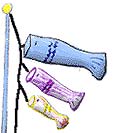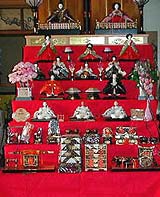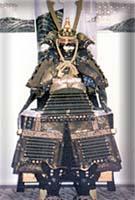| ||||||||||||||||||||||||||||||||||||||||||
|
GIRLS' DAY (MARCH 3)
Hina matsuri is a girl's festival (also called 'Dolls Festival'). This is celebrated2 because the parents want their children to grow strong and healthy. This happens on March 3rd (third day of third month). On this day parents of the girls get a doll shrine. My house in Japan was small so we only set up the first step of the shrine but actually there are more. It doesn't matter how many steps there are but the nice ones have about 8 steps in total. The doll shrine is covered with red cloth. These dolls are called hina ninngjyow. Hina means princess and ninngiyow means doll. These dolls represent a royal family in Japan, long time ago, in Heangidai Heian period (794-1192) about 1300 years ago. On the top step, there is an empress and an emperor and on the other steps are people the noble classes. On the second step there are three ladies holding Japanese rice cakes. On the third step there are five musicians holding Japanese traditional instruments and on the 4th step there are four men and beside them there are two cherry blossoms3. On the last step in this picture there are 10 pieces of furniture.During Hina matsuri girls wear kimonos and they eat hina-arale, The children drink ama-sake, a rice wine that is made especially for girls during Hina matsuri. It has no alcohol in it so children can drink it without worrying. Boys' Day (May 5)
On this day we don't have to go to school. Only boys on this day wear something called Gogatsu-ningyo, dolls of famous warriors5 and other heroes. This is the cabuto I have made. This cabuto actually came from this armor. The armor is only for looking at and it is not meant to be worn.  On this day we eat kashiwamochi. This is a rice cake, which is covered up with a leaf we can eat and filled with bean paste. Children love to eat this. On this day we eat kashiwamochi. This is a rice cake, which is covered up with a leaf we can eat and filled with bean paste. Children love to eat this.
点击  收听单词发音 收听单词发音
|
||||||||||||||||||||||||||||||||||||||||||
上一篇:各国庆祝方式大比拼 下一篇:March:Mardi Gras(四旬斋前的狂欢节) |
||||||||||||||||||||||||||||||||||||||||||
- 发表评论
-
- 最新评论 进入详细评论页>>


 Kodomo-no-i is a day for children. This festival happens on 5th of May (fifth day of fifth month). Well, actually it is suppose to be "Children's Day" everyone calls it "Boy's Day". On "Boy's Day", the family who has a son goes outside and flies huge carp-shaped streamers (koinobori) (see picture right) in their garden. Actually the height of this is really as tall as a 3-story house. Girls do not have this but our family has one because I begged my father. (Click on the
Kodomo-no-i is a day for children. This festival happens on 5th of May (fifth day of fifth month). Well, actually it is suppose to be "Children's Day" everyone calls it "Boy's Day". On "Boy's Day", the family who has a son goes outside and flies huge carp-shaped streamers (koinobori) (see picture right) in their garden. Actually the height of this is really as tall as a 3-story house. Girls do not have this but our family has one because I begged my father. (Click on the 

